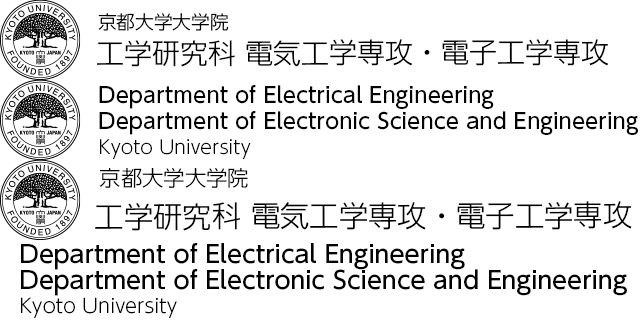Outline
General Outline
Up to now, the Department of Electrical Engineering and Department of Electronic Science and Engineering have been administered under a unified organizational structure. At the same time, however, both have pursued research in their fields of specialization independently. Taking advantage of the opportunities presented by the 21st COE project (started in 2002) followed by the global COE project (started in 2007), and their relocation to Kyoto University's Katsura Campus, the two departments are striving to establish new academic and engineering disciplines while embracing interactions with the real world, as described in detail in the items below, through a strong emphasis on fundamental research. They are pursuing this goal through a collaboration that aims at integrating and fusing their academic achievements based on a broad outlook of the future of electric and electronic-related scientific disciplines. In addition, the departments are working to create a center of research and education for fundamental electrical and electronic technologies by actively hosting talented foreign researchers and investing in efforts to train highly capable researchers and engineers of outstanding international perspective.
Outline of the Department of Electrical Engineering
The Department of Electrical Engineering conducts theoretical research on electromagnetic field theory, electric circuit theory, and system and control theory, as well as experimental research relating to the fundamental principles and applications of these disciplines. More specifically, the department engages in the following studies: fast and accurate electromagnetic field simulation and the analysis of lightning surge phenomena using parallel computing; high-voltage engineering and electromagnetic environmental problems; the design of microelectronics circuits; generation, transmission, and conversion of electrical energy and its effective utilization; various applications of superconductivity phenomena; large-scale computation and simulation; automatic control; measurement; human-machine systems; and bio-systems and medical systems. The items below currently serve as the pillars of the department's research and development work.
- Research on basic theory and its application: Highly efficient and accurate electromagnetic field analysis of various media; analysis of the impact of electromagnetic fields on living organisms; and the development of methods for analyzing electromagnetic wave circuits and technology for making dedicated algorithm processors.
- Research on electrical energy: Development of technology that uses superconductivity for high-efficiency, effective utilization of electrical energy; development of environment-friendly high-voltage insulation methods; and effective operation of electric power systems by direct-current transmission using distributed power sources.
- Research on electrical systems and control: Development of technologies to control the depth of intravenous anesthesia and to control intraocular pressure in cataract surgery; development of mathematical techniques and implementation methods to analyze the robustness of digital control systems.
- Research on radio engineering including space radio science and engineering and microwave enrgy transmission and information media engineering including information visualization and mutimedia science.
Outline of the Department of Electronic Science and Engineering
The Department of Electronic Science and Engineering engages in education and research on advanced engineering technology for creating the hardware that serves as the basis of electronics. The department is working actively on the following: the development of new device functions through miniaturization and integration; the development of sources for generating electrons, ions and plasmas, and their application to device manufacturing; the creation of new functional materials and devices by controlling semiconductor interfaces and surfaces, dielectric, and organic molecular materials; and the development of new optical materials and photonic devices by using the quantum effects of electrons and light, and their applications to electronics. The three items below currently serve as the pillars of the department's research and development work.
- Research on new, high-performance electronic materials: Research on crystal growth and fundamental physical properties of various electronic materials, such as SiC and III-V group wide-gap semiconductors, composite oxide dielectric and magnetic materials, and organic molecular semiconductors, with a view to the post-silicon age and new applications.
- Research on new functional devices and systems: Development and integration of high-temperature superconductivity devices, giant magnetoresistance devices, SiC devices for power electronics, blue to ultraviolet luminescence devices, various display devices, molecular memory devices, and 2D and 3D photonic devices; and research on the fundamentals of quantum measurement and quantum computing.
- Research on processing methods for hyperfine materials: Development of tools for new processes using positive and negative ions and their clusters, or plasma; and research on technologies for new applications.
